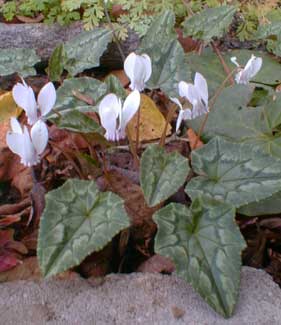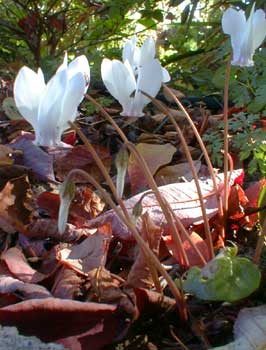
Double-shield Sagittate
White Autumn Cyclamen
"Water & dirt stand up
in the cyclamens &
invite the sun to breakfast."
-Dave Pratt,
Cleveland
Cleveland
"Double-shield Sagittate" Cyclamen hederifolium ssp hederifolium var albiflorum is distinguished by its white flower, arrow-shaped leaf usually deckled, with a pewter heart inside the green silhouette at the center of the silver-mottled leaves.
 There is great variety within this broad form. The regular patternleaf varieties will have pretty much the same leaf but without the cloudy heart inside the fir-tree or arrow silhouette (compare photos of the single-shield type on the Basic Patternleaf White page).
There is great variety within this broad form. The regular patternleaf varieties will have pretty much the same leaf but without the cloudy heart inside the fir-tree or arrow silhouette (compare photos of the single-shield type on the Basic Patternleaf White page).The first photo from October (2003) shows a typical specimen. This one blooms in September, has its leaves well up by mid-October with flowers still going gung-ho. It can flower into November, though a couple of single-shield whites growing not eight feet away will stop flowering sooner, there being great diversity in timing as well as appearance of autumn cyclamens.
The otherwise white flowers have a pink nose. The second photo shows the flowers in September before leaves have much emerged. Falling chokecherry leaves have to be kept off the developing cyclamens, but so long as the autumn leaf-fall does not smother them, they love the protection of a loose mulch & as it turns to leaf-mold through the winter & early spring, the cyclamens demand no further fertilizing than that.
Young tubers are frequently called "corms" even by growers who know better; they are actually tubers & at maturity are disc-shaped. The tuber can live a century or longer, & eventually get as big around as a frisbee, though I've never personally seen one larger than a moon pie.
These should never be planted too deeply. In colder zones (they will succeed down to Zone 5 easily & potentially to Zone 4) they may need mulching over the shallowly placed tuber, & may want a bit more sun. In our mild Zone 8, they want partial shade (& succeed in full shade) in humusy well-drained moist soil (but succeed in entirely dry shade as well). They're not called "hardy cyclamens" for nothing; it is extremely easy to succeed with these.
Continue to
Cyclamen hederifolium ssp hederifolium, Magenta